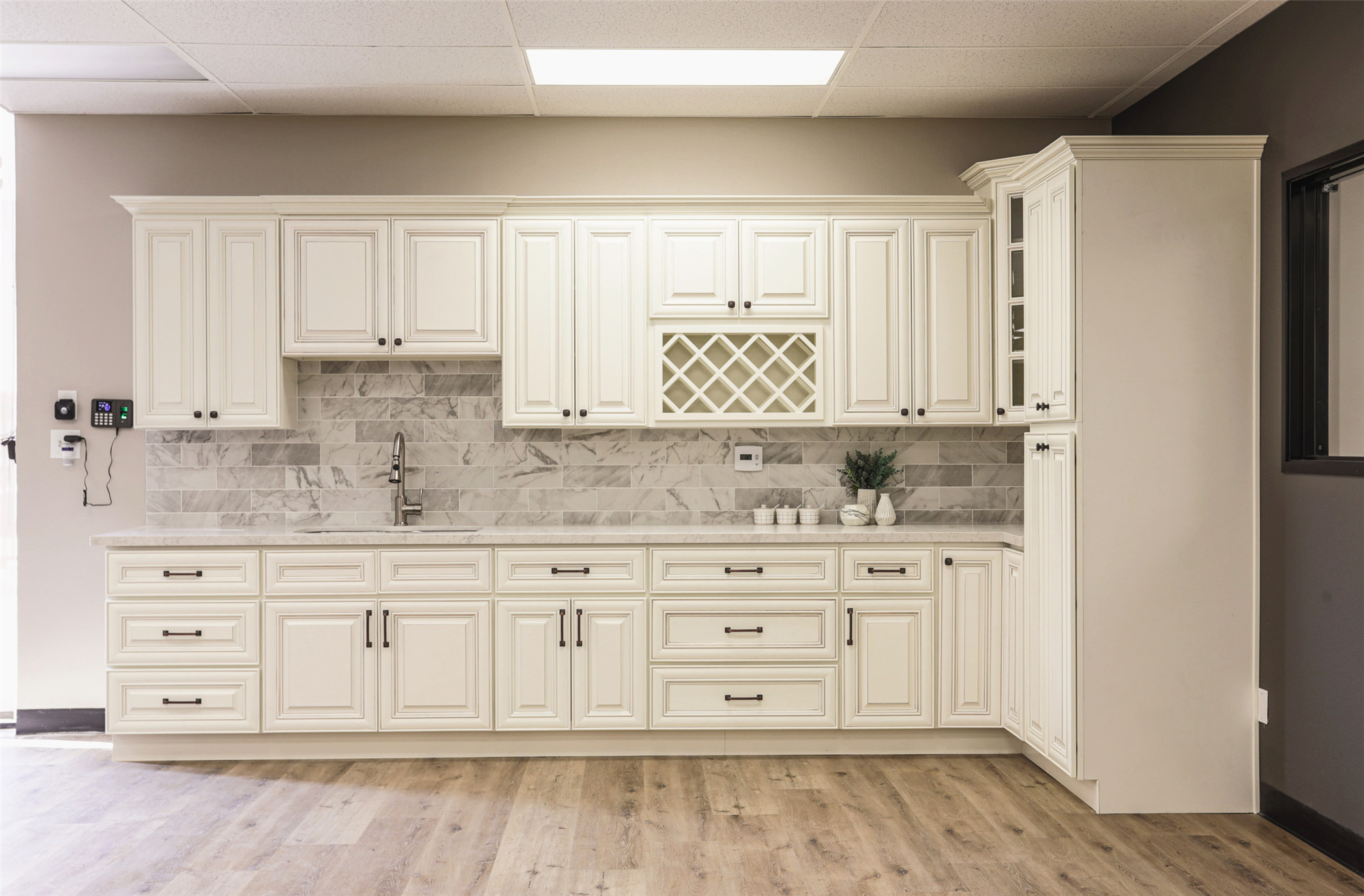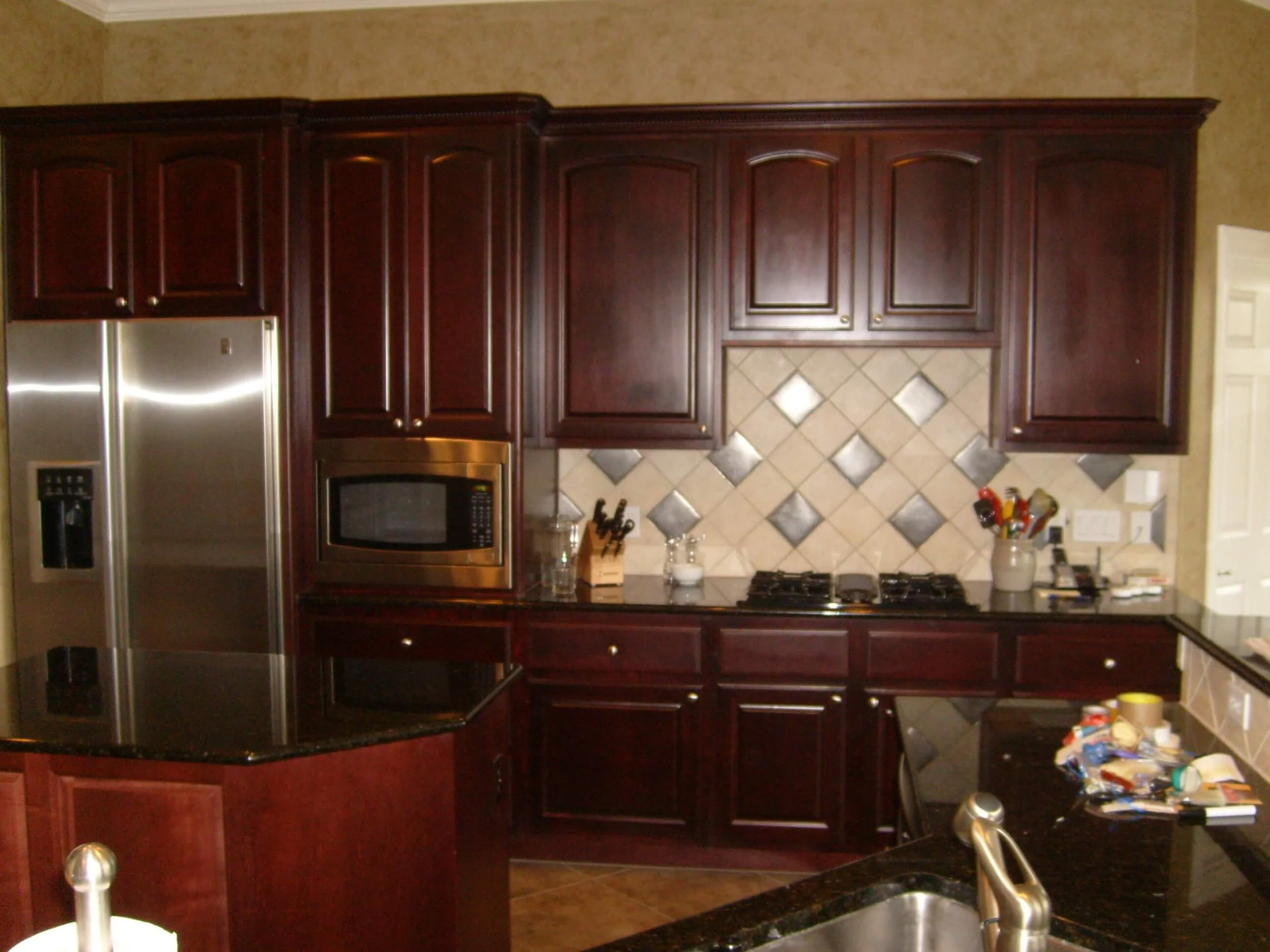Aesthetic Appeal of Antique Brown Kitchen Cabinets
Antique brown kitchen cabinets offer a timeless charm and enduring elegance that transcends fleeting trends. Their rich hues and varied textures bring warmth and sophistication to any kitchen, creating a space that feels both inviting and refined. This enduring appeal stems from a blend of historical influences and the inherent beauty of the wood itself.
Styles and Design Elements of Antique Brown Kitchen Cabinets
Antique brown kitchen cabinets encompass a broad spectrum of styles, reflecting diverse historical periods and regional influences. Shaker-style cabinets, characterized by their simple, clean lines and lack of ornamentation, often feature a rich, dark brown finish. Conversely, Victorian-era cabinets might boast intricate carvings, ornate detailing, and a darker, more polished brown tone. Mission-style cabinets, popular in the early 20th century, tend towards a simpler, more rustic aesthetic, often using a medium brown stain that showcases the natural wood grain. The wood types used vary significantly, with oak, cherry, mahogany, and walnut being common choices. Finishes range from a matte, slightly distressed look to a high-gloss, polished sheen, each imparting a distinct character to the cabinets. For example, a distressed oak finish would evoke a rustic farmhouse feel, while a highly polished mahogany finish would lend an air of classic luxury.
Comparison of Antique Brown and Modern Cabinet Styles
Antique brown cabinets offer a distinct advantage over many modern styles: their enduring appeal. Modern trends, often characterized by sleek minimalism or bold colors, can quickly become dated. Antique brown cabinets, on the other hand, maintain their elegance over time, offering a timeless investment. However, modern cabinets often provide greater customization options and may incorporate features like soft-close hinges and advanced storage solutions, which are less common in antique styles. Modern cabinets can also be more easily integrated into contemporary kitchen designs. The disadvantage of antique cabinets can be their higher cost, especially if sourcing authentic antique pieces, and the potential need for more extensive restoration or maintenance. Modern cabinets, conversely, often offer greater affordability and lower maintenance requirements.
Mood Boards: Interior Design Styles Complementing Antique Brown Cabinets
Several interior design styles beautifully complement antique brown kitchen cabinets.
A rustic farmhouse style uses a palette of creamy whites, soft greys, and natural wood tones, accented with pops of color from vintage textiles and farmhouse-style accessories. Natural textures, like linen, burlap, and woven baskets, enhance the rustic charm. Materials such as reclaimed wood and stone add to the authenticity. Imagine a kitchen with whitewashed walls, a distressed wooden table, and wrought iron accents.
A traditional style incorporates richer, deeper colors such as burgundy, emerald green, and gold. Luxurious materials like velvet, silk, and marble are incorporated. This style creates a sophisticated and opulent atmosphere. Visualize a kitchen with dark wood floors, plush velvet chairs, and gleaming brass hardware.
An eclectic style blends various elements from different eras and cultures. It might incorporate antique brown cabinets with brightly colored walls, mismatched chairs, and globally inspired accessories. The result is a unique and personalized space with a sense of history and character. Picture a kitchen where the antique cabinets are paired with vibrant Moroccan tiles, a vintage Persian rug, and eclectic artwork.
Video Script: Versatility of Antique Brown Kitchen Cabinets
(Scene 1: Rustic Farmhouse)
Narrator: Antique brown cabinets effortlessly blend into a rustic farmhouse kitchen. Warm, natural light streams through a large window, illuminating the creamy white walls and the rich brown wood of the cabinets. A large, farmhouse-style table sits in the center of the room, surrounded by simple wooden chairs. Copper pots and pans hang above the stove, adding to the rustic charm.
(Scene 2: Traditional Kitchen)
Narrator: In this traditional setting, the antique brown cabinets exude sophistication. Subdued lighting creates a warm and inviting ambiance. Elegant brass hardware complements the deep brown finish. A crystal chandelier hangs above a large, polished wooden table. Fine china and silverware are displayed on open shelving.
(Scene 3: Eclectic Kitchen)
Narrator: The versatility of antique brown cabinets shines in this eclectic kitchen. Bright, bold colors on the walls create a lively contrast to the rich brown tones of the cabinets. A mix of modern and vintage accessories adds a touch of whimsy and personality. The lighting is brighter and more modern, showcasing the unique blend of styles.
Restoration and Maintenance of Antique Brown Kitchen Cabinets

Preserving the beauty and longevity of antique brown kitchen cabinets requires a dedicated approach to both cleaning and repair. Understanding the nuances of wood care and restoration techniques is crucial for maintaining their value and aesthetic appeal. This section details practical steps and methods for keeping these cabinets in pristine condition for years to come.
Cleaning and Maintaining Antique Brown Kitchen Cabinets
Regular cleaning is the first line of defense against damage and deterioration. A gentle approach is essential to avoid scratching the delicate finish. Begin by dusting the cabinets regularly with a soft, dry microfiber cloth. For more thorough cleaning, use a damp (not wet) cloth with a mild dish soap solution. Avoid harsh chemicals, abrasive cleaners, and excessive water, which can damage the wood and finish. After cleaning, immediately dry the cabinets thoroughly with a clean, dry cloth to prevent water damage. For stubborn grease or grime, a specialized wood cleaner formulated for antique furniture can be used sparingly, following the manufacturer’s instructions carefully. Finally, consider applying a high-quality furniture polish specifically designed for wood to enhance the shine and protect the finish. Regular polishing helps repel dust and moisture, extending the life of the cabinets.
Repairing Common Damage to Antique Brown Kitchen Cabinets
Antique brown kitchen cabinets are susceptible to various types of damage over time. Scratches are common, often caused by accidental impacts or dragging of cookware. Small scratches can be buffed out using a fine-grit sandpaper (220-grit or higher) followed by polishing. For deeper scratches, wood filler matching the cabinet’s color can be applied, sanded smooth, and then stained and finished to match the surrounding area. Water damage, often manifesting as warping or discoloration, requires more extensive repair. If the damage is minor, careful drying and refinishing may suffice. However, severe water damage might necessitate professional intervention. Loose hinges or handles are easily replaced, often requiring only a screwdriver. If the wood itself is damaged, such as from rot or insect infestation, specialized wood repair products and techniques, or even professional intervention, might be necessary. For example, a wood hardener can be applied to stabilize damaged wood before further repairs.
Updating or Modernizing Antique Brown Kitchen Cabinets
Updating antique brown kitchen cabinets doesn’t necessitate a complete overhaul. Subtle changes can significantly refresh their look without sacrificing their original charm. A fresh coat of paint, chosen to complement the existing kitchen décor, can provide a modern twist. Distressing techniques, involving lightly sanding or applying a glaze to create a weathered appearance, can add character and texture. Replacing the existing hardware with updated knobs and pulls, while staying true to the cabinet’s style, can offer a sophisticated update. For instance, swapping out dated brass knobs for sleek brushed nickel pulls can provide a significant visual change. Alternatively, a more subtle update might involve simply replacing worn-out hinges. These techniques allow for personalization while respecting the history and craftsmanship of the cabinets.
Resources for Finding Replacement Parts and Accessories
Finding replacement parts for antique brown kitchen cabinets may require some research. Antique dealers specializing in vintage kitchenware often carry a selection of original or reproduction parts. Restoration specialists possess the expertise to repair or reproduce damaged or missing components. Online retailers, specializing in antique furniture parts or hardware, offer a vast selection of knobs, pulls, hinges, and other accessories. Local antique shops or flea markets can also be excellent resources for finding unique and period-appropriate replacement parts. Searching online auction sites can also yield unexpected finds. Thorough research and careful selection are key to maintaining the integrity and value of the cabinets.
Integrating Antique Brown Kitchen Cabinets into Modern Homes

The inherent richness and character of antique brown kitchen cabinets present a unique challenge and exciting opportunity in contemporary home design. Successfully integrating these pieces requires a delicate balance between honoring their traditional aesthetic and creating a cohesive, modern kitchen space. The key lies in thoughtful selection of complementary elements and a keen eye for detail.
Balancing Traditional and Modern Aesthetics
Antique brown cabinets, with their often ornate detailing and deep, warm tones, can easily overwhelm a modern kitchen if not carefully considered. The solution isn’t to strip away the cabinets’ character, but rather to carefully select modern elements that complement, rather than clash. Stainless steel appliances, while a staple of modern kitchens, can work surprisingly well; the cool metallic tones provide a striking contrast against the warm wood, creating a visually interesting juxtaposition. Similarly, sleek, minimalist countertops in materials like quartz or marble offer a clean, contemporary counterpoint to the cabinets’ more traditional styling. The use of brushed nickel or chrome hardware further enhances this contrast, offering a refined modern touch without sacrificing the overall aesthetic. A successful integration might involve pairing antique brown cabinets with a bright, white backsplash, allowing the cabinets to serve as a grounding feature while the backsplash adds a fresh, modern element.
Design Choices for Cohesive Appearance
Creating a cohesive look requires a deliberate approach to design choices. Consider the overall color palette. While the antique brown cabinets will naturally dominate the color scheme, incorporating lighter, brighter colors elsewhere in the kitchen – on walls, backsplashes, or countertops – can prevent the space from feeling too dark or heavy. Natural light plays a crucial role; maximizing natural light through window placement and careful lighting design can brighten the space and mitigate the potential for a dark, claustrophobic feel. Furthermore, strategic use of open shelving can incorporate modern design elements while showcasing attractive dishware or cookware, providing a visual break from the more traditional aesthetic of the cabinets. Careful consideration should be given to the choice of flooring; light-colored wood or tile flooring can create a sense of spaciousness and balance the darker cabinets.
Transitioning to Other Areas of the Home
Seamlessly transitioning from the kitchen to other areas of the home involves extending key design elements. If the kitchen features a white backsplash, for example, consider using white or off-white paint in adjacent rooms to maintain a sense of visual continuity. Similarly, if the kitchen flooring is light-colored wood, extending that flooring into a nearby hallway or dining area creates a cohesive flow. The use of consistent lighting fixtures – perhaps sleek, modern pendant lights – throughout the home can further unify the design. Incorporating similar materials, such as wood accents, in other rooms can subtly link the different spaces while maintaining distinct personalities. A consistent color palette, incorporating variations of the brown tones found in the cabinets, can further enhance this sense of cohesion. For instance, a darker brown accent wall in the living room could subtly echo the kitchen’s cabinetry without directly mirroring it.

